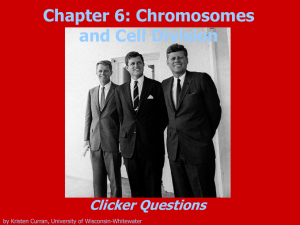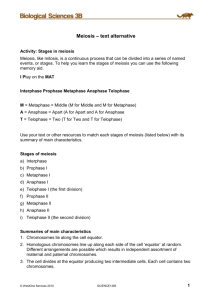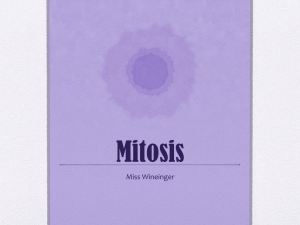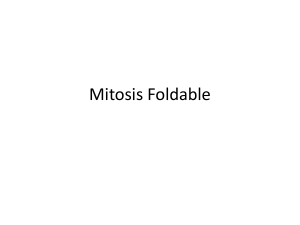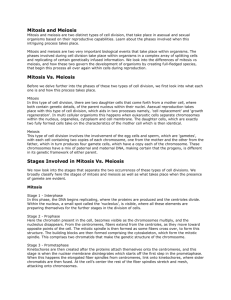Mitosis and Meiosis
advertisement
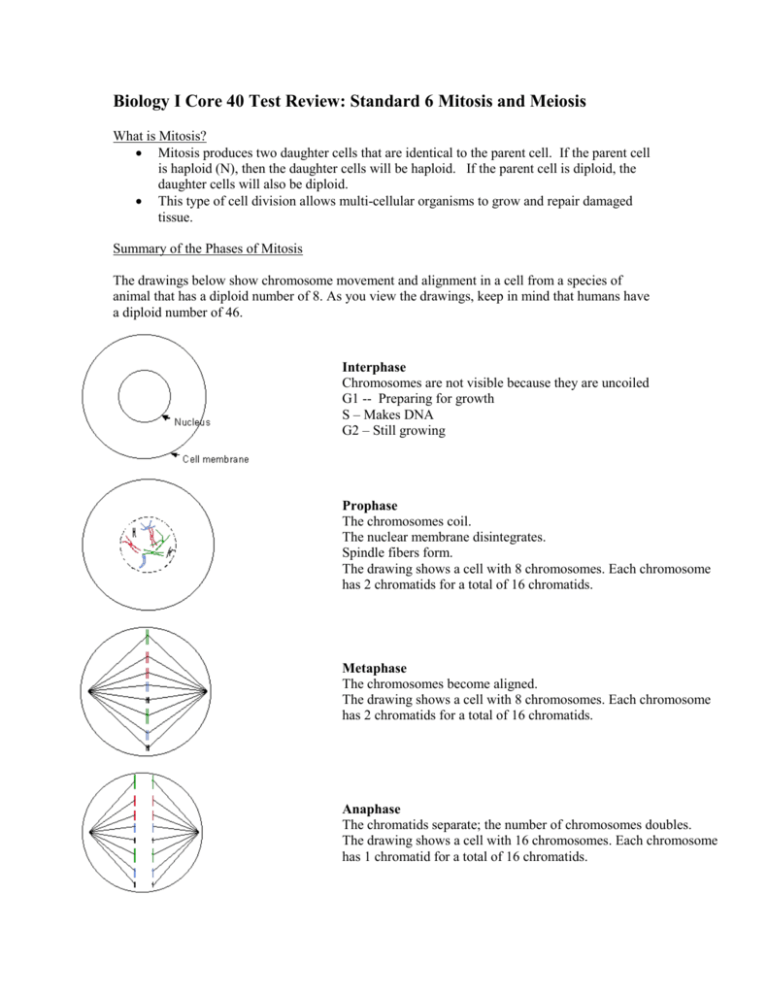
Biology I Core 40 Test Review: Standard 6 Mitosis and Meiosis What is Mitosis? Mitosis produces two daughter cells that are identical to the parent cell. If the parent cell is haploid (N), then the daughter cells will be haploid. If the parent cell is diploid, the daughter cells will also be diploid. This type of cell division allows multi-cellular organisms to grow and repair damaged tissue. Summary of the Phases of Mitosis The drawings below show chromosome movement and alignment in a cell from a species of animal that has a diploid number of 8. As you view the drawings, keep in mind that humans have a diploid number of 46. Interphase Chromosomes are not visible because they are uncoiled G1 -- Preparing for growth S – Makes DNA G2 – Still growing Prophase The chromosomes coil. The nuclear membrane disintegrates. Spindle fibers form. The drawing shows a cell with 8 chromosomes. Each chromosome has 2 chromatids for a total of 16 chromatids. Metaphase The chromosomes become aligned. The drawing shows a cell with 8 chromosomes. Each chromosome has 2 chromatids for a total of 16 chromatids. Anaphase The chromatids separate; the number of chromosomes doubles. The drawing shows a cell with 16 chromosomes. Each chromosome has 1 chromatid for a total of 16 chromatids. Telophase The cell divides into two. The chromosomes uncoil. The nucleus reforms. The spindle apparataus disassembles. The drawing shows a cell with 16 chromosomes. Each chromosome has 1 chromatid for a total of 16 chromatids. G1 Interphase The chromosomes have one chromatid. The drawing shows two cells. Each cell has 8 chromosomes. Each chromosome has 1 chromatid for a total of 8 chromatids per cell. G2 Interphase The chromosomes have two chromatids each. The drawing shows two cells. Each cell has 8 chromosomes. Each chromosome has 2 chromatids for a total of 16 chromatids per cell. What is Meiosis? Meiosis produces daughter cells that have one half the number of chromosomes as the parent cell. 2N ? N Meiosis enables organisms to reproduce sexually. Gametes (sperm and eggs) are haploid. Meiosis involves two divisions producing a total of four daughter cells. Summary of the Phases of Meiosis A cell undergoing meiosis will divide two times; the first division is meiosis 1 and the second is meiosis 2. The phases have the same names as those of mitosis. A number indicates the division number (1st or 2nd): meiosis 1: prophase 1, metaphase 1, anaphase 1, and telophase 1 meiosis 2: prophase 2, metaphase 2, anaphase 2, and telophase 2 In the first meiotic division, the number of cells is doubled but the number of chromosomes is not. This results in 1/2 as many chromosomes per cell. The second meiotic division is like mitosis; the number of chromosomes does not get reduced. Prophase I Homologous chromosomes become paired. Crossing-over occurs between homologous chromosomes. Crossing over Metaphase I Homologous pairs become aligned in the center of the cell. The random alignment pattern is called independent assortment. For example, a cell with 2N = 6 chromosomes could have any of the alignment patterns shown at the left.. Anaphase I Homologous chromosomes separate. Telophase I This stage is absent in some species Prophase II Metaphase II Anaphase II Telophase II Daughter Cells At one time, interphase was referred to as the resting phase of the cell cycle. Why do you think this description is no longer used? ___________________________________________________________________________ ___________________________________________________________________________ ___________________________________________________________________________ ___________________________________________________________________________ ___________________________________________________________________________ ___________________________________________________________________________ ___________________________________________________________________________ Compare and contrast mitosis and meiosis. Mitosis BOTH Meiosis A population of fish lives in a pond near an industrial park. Many of the fish develop abnormal growths on their gills, but the growths do no affect their survival. Describe a potential cause of this growth and what happens within the cells. Is it likely that this trait will be inherited by the next generation? Explain why or why not?




